The Extended Euclidean Algorithm finds a
linear combination of m and n equal to ![]() . I'll begin by reviewing the Euclidean algorithm, on which the extended
algorithm is based.
. I'll begin by reviewing the Euclidean algorithm, on which the extended
algorithm is based.
The Euclidean algorithm is an efficient way of computing the greatest common divisor of two numbers. It also provides a way of finding numbers a, b, such that
![]()
The Euclidean Algorithm. Take ![]() . Define
. Define
![]()
Then recursively define ![]() using the Division
Algorithm:
using the Division
Algorithm:
![]()
The inequality ![]() shows that the
shows that the
![]() 's form a decreasing sequence of
nonnegative integers. It follows that the algorithm must terminate.
's form a decreasing sequence of
nonnegative integers. It follows that the algorithm must terminate.
For instance, to cmpute ![]() :
:

We usually write this in tabular form:

The greatest common divisor is the last nonzero remainder: ![]() .
.
According to an earlier result, the greatest common divisor 29 must
be a linear combination ![]() . Here's a tedious way to find integers a and b which
work. Simply work backwards through the equations above, treating
the
. Here's a tedious way to find integers a and b which
work. Simply work backwards through the equations above, treating
the ![]() 's as if they were variables.
's as if they were variables.
![]()
Substituting for 87 in the first equation,
![]()
But
![]()
Substituting for 116, I find that
![]()
I've written the greatest common divisor 29 as a linear combination of the original numbers 1914 and 899.
While you can use this back-substitution approach to write the greatest common divisor as a linear combination of the original numbers, it's rather tedious. Here's a better way. I'll write it more formally, since the steps are a little complicated.
I proved the next result earlier, but the proof below will actually give an algorithm which constructs a linear combination. It is called a backward recurrence, and is due to S. P. Glasby [1]. It will look a little complicated, but you'll see that it's really easy to use in practice.
Theorem. ( Extended Euclidean
Algorithm) ![]() is a linear
combination of a and b: For some integers s and t,
is a linear
combination of a and b: For some integers s and t,
![]()
Warning: s and t are not unique.
Proof. ![]() is only defined if at least one of a, b is
nonzero. If
is only defined if at least one of a, b is
nonzero. If ![]() ,
, ![]() and
and ![]() . This proves the
result if one of the numbers is 0, so I may as well assume both are
nonzero. Moreover, since
. This proves the
result if one of the numbers is 0, so I may as well assume both are
nonzero. Moreover, since ![]() , I can assume both numbers are
positive.
, I can assume both numbers are
positive.
Suppose ![]() . Apply the Euclidean Algorithm to
. Apply the Euclidean Algorithm to
![]() and
and ![]() , and suppose that
, and suppose that ![]() is the last nonzero remainder:
is the last nonzero remainder:
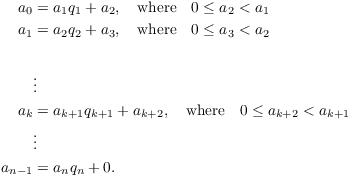
I'm going to define a sequence of numbers ![]() ,
, ![]() , ...
, ... ![]() ,
, ![]() . They will be constructed recursively,
starting with
. They will be constructed recursively,
starting with ![]() ,
, ![]() and working downward to
and working downward to ![]() . (This is why this is called a
backward recurrence.)
. (This is why this is called a
backward recurrence.)
Define ![]() and
and ![]() . Then define
. Then define
![]()
Now I claim that
![]()
I will prove this by downward induction, starting with ![]() and working downward to
and working downward to ![]() .
.
For ![]() , I have
, I have
![]()
The result holds for ![]() .
.
Next, suppose ![]() . Suppose the result holds
for
. Suppose the result holds
for ![]() , i.e.
, i.e.
![]()
I want to prove the result for k. Substitute ![]() in the preceding
equation and simplify:
in the preceding
equation and simplify:
![]()
![]()
![]()
This proves the result for k, so the result holds for ![]() , by downward induction.
, by downward induction.
In particular, for ![]() , the result says
, the result says
![]()
Since ![]() , I've expressed
, I've expressed ![]() as a linear combination of
as a linear combination of ![]() and
and ![]() .
.![]()
There are many algorithms (like the one in the proof) which produce a linear combination, but I'll call this one the Extended Euclidean Algorithm.
Example. Compute ![]() and express it as a linear combination of
187 and 102.
and express it as a linear combination of
187 and 102.
I'll arrange this computation in the form of a table; it's just an extension of the table I used for the Euclidean algorithm.
Here's how you start:
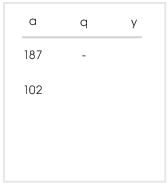
(You can save a step by putting the larger number first.)
The a and q columns are filled in using the Euclidean algorithm, i.e. by successive division: Divide the next-to-the-last a by the last a. The quotient goes into the q-column, and the remainder goes into the a-column.
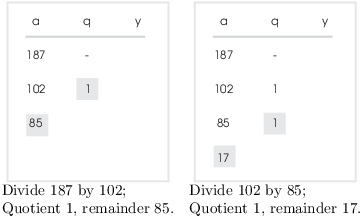
When the division comes out evenly, you stop. In this case, 85 divided by 17 is 5, with remainder 0.
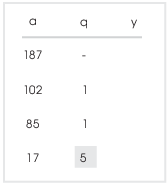
The last entry in the a-column is the greatest common divisor. Thus,
![]() .
.
The y-column is filled in from bottom to top. Always start with 0 for the last y and 1 for the next-to-the-last y.

Then, working from bottom to top, fill in the y's using the rule
![]()
It's probably easier to show than it is to explain:

To get the linear combination, form the products diagonally and subtract one from the other:
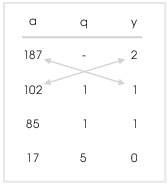
Thus,
![]()
How do you know the order for the subtraction? The proof gives a formula, but the easiest thing is to pick one of the two ways, then fix it if it isn't right. If you subtract "the wrong way", you'll get a negative number. For example,
![]()
Since I know the greatest common divisor should be 17 --- it's the last number in the a-column --- I just multiply this equation by -1:
![]()
This way, you don't need to memorize the exact formula.![]()
Example. Compute ![]() and express it as a linear combination of
246 and 194.
and express it as a linear combination of
246 and 194.
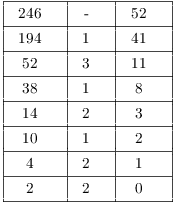
Thus,
![]()
I think this algorithm is the best for hand computation. For implementation on a computer, it has a drawback: You need to store all the Euclidean algorithm quotients, because you need to work your way backward up the table. There is another version of this algorithm which only requires that you save a couple of table lines at a time; it is not as good for hand computation, since you need two helper variables x and y and two multiplications at each step.
Copyright 2019 by Bruce Ikenaga